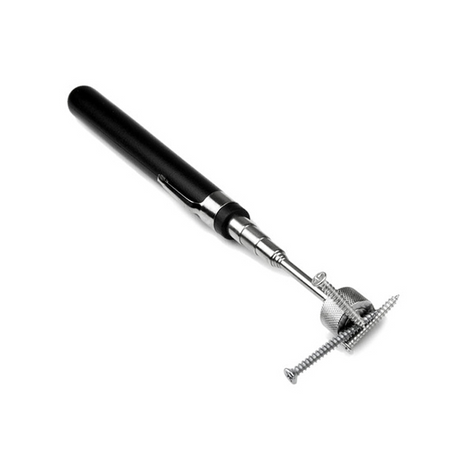We are often asked if a magnet can be switched off (and then switched on again). We try here with a not-too-technical review of different ways in which you can turn off magnets, so to speak.
If you must use a magnet , which should only work when you need it, then you can use something as simple as distance - ie. air or something else as a spacer. Take, for example, a magnetic collector< /a>: there are many magnetic collectors that just work all the time, but it can be difficult with strong magnets, because on the one hand you want the magnet to be strong enough to work over a larger area and attract from everyone sides of. But if you have to pick up things like screws, nails, iron shavings or capsules, you want to be able to easily remove the metal parts from the magnet again. Therefore, larger magnetic collectors are often built with a handle, where the magnet lies completely flat at the bottom of the collector when you take it into use, but when the magnet has to be "turned off", you pull the handle on the magnetic collector, and then the distance is , which is created, enough to let go of the metal parts.
If, on the other hand, you simply need a safe way to store a strong magnet in the drawer etc., then you can wrap it in a box with some flamingo or other packing stuffing, or you can wrap bubble wrap or a tea towel around the magnet. The distance created with air and/or other materials is enough to make the magnet passive and therefore not magnetic to other things when you are not using it.
BUT : it does not turn off the magnet completely. It just means that it is "passivized".
How it works with fire doors etc.
Fire doors are often made with electromagnetism to be able to close automatically on the fire doors in larger buildings in case of fire. That is they are held open against the wall with a magnet when everything is everyday without danger (i.e. there is a magnet in the wall and then the door itself is made of magnetic metal). But if the building is on fire, the electronics will "turn off" the magnets on the fire door, and then they close automatically. The magnets can then work normally again when the fire is out and the doors must be open again. But it also means that fire doors will close at Alm. power cuts, and it is not always well thought out.
I actually have a story from many years ago, when I worked at a large law office in inner Copenhagen. Together with 3 colleagues, I was locked in behind two huge fire doors due to an extensive power cut in Copenhagen, and here we were locked in for many hours until the power came back on. In the event of a fire, we would be safe from flames, but there was no thought of an escape route, so it was lucky that the building did not burn, so that this "detail" could be taken care of afterwards and make it safe not only for the building but also for people in the building, so that the only escape route in case of fire was not out of the window from the 3rd floor.
A simple solution on a smaller scale - without electromagnetism - could be to insert a split in the same triangular shape as a wedge so that you can easily push it in front of the magnet in the wall and thereby create enough distance for the magnetism to let go so that the door slams shut. If you don't have a metal door (like a fire door), then you can put a piece of metal or another magnet on the door as counter pole to the magnet on the wall.




































